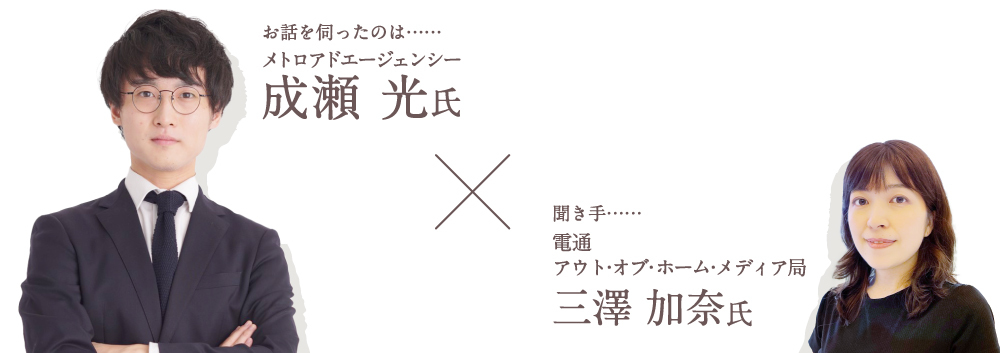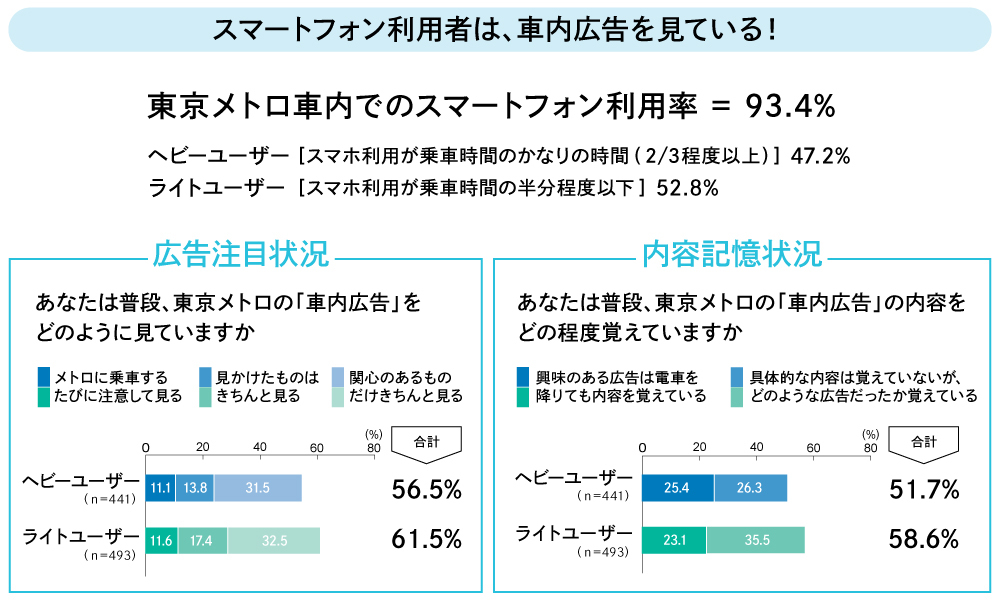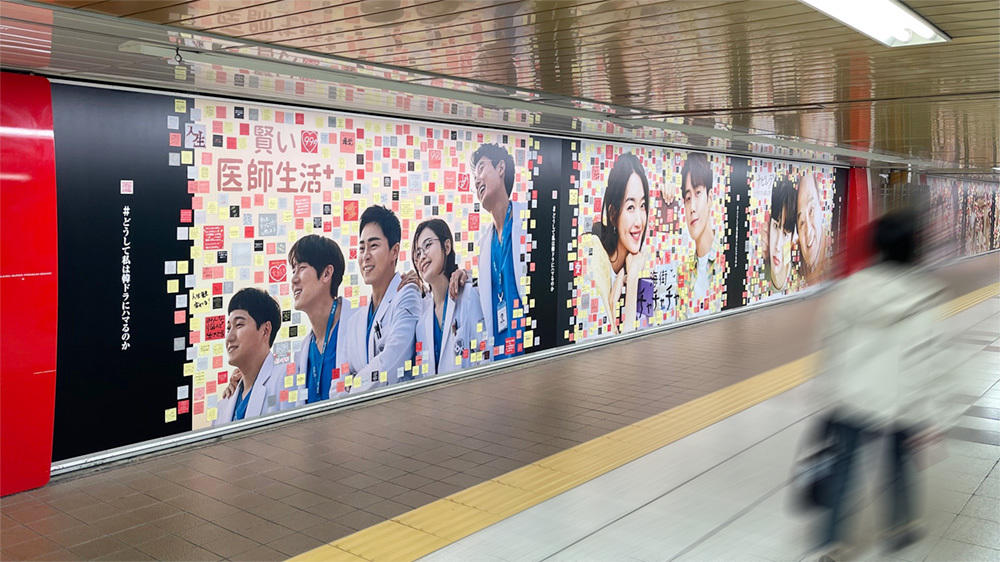Note: This website was automatically translated, so some terms or nuances may not be completely accurate.
Transportation advertising is evolving amid the COVID-19 pandemic!
This series has explored the new standards and new normal in the OOH (Out Of Home: outdoor advertising and transit advertising) industry from various angles. For the final installment, we speak with Hikaru Naruse of Metro Ad Agency about recent trends in transit advertising.

──First, I'd like to ask about "in-vehicle advertising." Many people are looking at their smartphones inside trains. Moreover, with fewer passengers due to the pandemic, the significance of in-vehicle advertising seems to be questioned. Are in-vehicle ads actually being seen? What value do they offer?
Advertisements do reach smartphone users. In 2020, our company conducted a survey on passenger behavior inside trains and at stations. The results showed that 93.4% of people use smartphones, and among them, over half actually view the in-train advertisements.

The defining characteristic of in-train advertising (transportation advertising) is that the ads and their placement locations serve as "real-life touchpoints" with consumers. Unlike web ads, the fact that passengers can actually see the creative while riding is a unique advantage of offline media.
Additionally, strengths include "repeated exposure" during essential commutes or school runs, and "high visibility" as the ads remain displayed throughout the ride. Furthermore, placement in spaces like trains and stations offers more than just visibility; it provides the appeal of a real-world "experience," akin to visiting a museum or event.
Other strengths include the low risk of brand damage due to placement in highly public transportation spaces, high affinity with mobile devices, and the potential for information diffusion via social media. Our research shows that over 50% of passengers use their smartphones to search for products or services, about 30% post on social media, and approximately 40% subsequently make a purchase.

──Especially in 2020 and 2021, opportunities to visit commercial facilities decreased due to the spread of COVID-19, but many people still used trains for commuting and school travel. Are there any notable advertising examples during the pandemic?
One example involved creating a real spatial experience through the train interior and advertising. For the 2021 Netflix film "Asakusa Kid," the advertising space was taken over inside the Retro Liner cars on the Tokyo Metro Ginza Line (running between Shibuya and Asakusa). The Retro Liner recreates the vehicle design of the Showa era. "Asakusa Kid" is set in Asakusa during the mid-Showa era (1960s-70s), making the advertising creative perfectly match the train's interior. The ability for passengers to directly experience the film's world at first glance is invaluable, especially during the pandemic when attracting audiences is challenging.

──In 2021, the discontinuation of hanging advertisements by weekly magazines became a topic as the end of an era for in-train advertising. What changes are emerging in this space?
It's shifting beyond mere reach to focus on creative breadth and leaving a strong impact. New applications for in-vehicle advertising are still being explored, enabling surprising developments. Last year, a mobile carrier promotion became the first to utilize a full-vehicle, single-side takeover of hanging advertisements. The sight of all hanging posters on one side of every vehicle across the entire Metro network displaying the same advertiser's message was striking. This likely also heightened engagement between the product and consumers.
SNS × Station Advertising = Buzz is Born
Recently, there has been an increase in initiatives that link SNS with transportation advertising to create topics that encourage target audiences to participate. For example, advertisements for popular Netflix Korean series like "Vincenzo," "Even If I Know," "Smart Doctor Life," and "Cha Cha Cha" displayed at Shinjuku Station are one such example.

Shinjuku Metro Super Premium Set... Allows for a single poster display of approximately 15m on the Tokyo Metro Shinjuku Station Metro Promenade. This popular media option enables a space takeover spanning about 60m during concentrated campaigns at Shinjuku Station.
This creative campaign used the hashtag "#WhyAmIAddictedToKoreanDramas " to gather online fan reactions to the shows and messages for the cast. These were then physically displayed as sticky notes on the advertisements. The immense passion of fans collected online was made tangible through offline transit advertising, sparking social media buzz.
Thus, transit advertising complements social media well and is often used as a campaign starting point. While attracting crowds to specific locations remains challenging during the pandemic, stations are constantly bustling with people, making them ideal for this kind of fan engagement.
──Speaking of ads that involve everyday people, "support ads" where consumers themselves take the lead in placing advertisements are also perfectly suited to the current era. Metro Ad Agency handles these "support ads." What led you to start offering them?
Support ads originated as a culture in South Korea, starting with fans pooling money to place advertisements supporting their idols. At Tokyo Metro, since Nogizaka46's group formation, fans have had a culture of celebrating members' birthdays with posters displayed at Nogizaka Station. For Nogizaka46 fans, Nogizaka Station is one of their "sacred sites," serving as a point of connection between fans and the group.
Recently, as the term "oshi-katsu" (supporting one's favorite) is increasingly used, I feel there's a growing trend of individuals and communities actively "supporting the people they like." Due to the actual increase in inquiries, Tokyo Metro clarified the rules and permissible media for display starting in fiscal year 2021, enabling applications for support advertisements. In transit advertising, we're seeing not only the traditional B2C model ("from companies to consumers") but also emerging C2B and C2C movements ("from consumers to companies or other people").
● For more on support ads, we recommend the following article:
Who Owns Advertising? The Potential of "Crowdfunding × Advertising"
──Finally, please tell us about your future challenges.
According to a Ministry of Land, Infrastructure, Transport and Tourism survey, usage at major terminal stations in the Tokyo metropolitan area recovered to 87% of pre-pandemic levels after Golden Week 2022. Beyond reach as a value, we aim to further enhance the unique appeal of transit advertising, such as the ability to deploy campaigns in real-world locations, as introduced earlier.
Another longstanding challenge has been the difficulty in quantifying the effectiveness of transit advertising. In 2022, we will challenge ourselves to "visualize" the value of transit advertising. In May 2022, we released a report on station media. This report introduces metrics such as "potential audience size" and "demographic breakdown by gender, age, etc."
Regarding the often-cited difficulty in obtaining transportation advertising data, our company participates in the " Transportation Advertising Measurement Standardization " initiative. This effort involves 11 entities, including railway operators and in-house agencies that sell and manage transportation advertising in the Kanto region. We are working to standardize effectiveness measurement using Wi-Fi and beacons, enabling us to clearly explain advertising results to our clients.
After the interview...
According to Metro Ad Agency research, over 90% of passengers on Tokyo Metro trains use smartphones. However, this doesn't mean passengers aren't seeing in-car ads; over half view the ads and retain them in their memory. This result highlights the strength of transit advertising integrated into daily commutes. Of course, advertising effectiveness is expected to vary based on variables like product characteristics, media plans, and creative execution.
Through the interviews, I concluded that maximizing the effectiveness of in-train advertising hinges on three key points.
First is creating simple brand experiences that don't require directing people to event venues. While predicting foot traffic in cities has become difficult due to the pandemic, trains, being infrastructure, are less affected than commercial facilities—a clear advantage. Displaying large graphics, taking over entire train cars, or implementing AR experiences in real spaces can deliver meaningful brand experiences.
Second is leveraging social media. While this campaign also utilized social media, creating buzz on these platforms is essential to reach a wider audience. Dentsu Inc. OOH Division is analyzing multiple campaign cases to establish patterns for creating viral buzz.
Third is the promotion and measurement of purchases via QR codes, which have been permitted. While QR codes within advertisements were previously banned to prevent unauthorized photography, they are now allowed when placement is carefully considered. This enables distributing product coupons to those who scan the code, implementing ads that reveal original content, and even measuring website visits and purchases driven by QR code scans. Advertising campaigns utilizing these new purchase pathways and measurement methods will likely increase going forward.

Life with COVID-19 has now entered its third year. This year's cherry blossom viewing and Golden Week were particularly memorable, as people gathering together for the first time in a long while looked genuinely happy. The spread of COVID-19 prompted many people to reevaluate their lifestyles and shift their perspectives. While new products, services, and consumption patterns emerged within these altered routines, how did encounters with other products change? Opportunities to gather in person—not just with friends, but with colleagues of different ages, relatives, or even strangers—decreased. Visits to commercial facilities and travel became less frequent. Consequently, chances for serendipitous discoveries of wonderful, unknown things likely diminished too.
Web services, in particular, impress me with their ability to understand user preferences the more they are used, delivering highly accurate product recommendations. However, it seems increasingly difficult to cultivate the ability to discover things we don't yet know about, things we unexpectedly love – in other words, to experience serendipity.
Outdoor advertising, including transit ads, is displayed in public spaces. It's a high-reach medium that can appeal to the second-largest number of consumers after television advertising. Outdoor advertising can make accidental contact with people while they're on the move, sparking thoughts like, "Huh, they have this product now? Maybe I'll get it for my family," or "I've been seeing this a lot lately—is it popular? I should try it." Now, as we fully appreciate the joy of freely moving outdoors alongside the enrichment of our time at home, it's precisely the right moment to reexamine new ways to utilize outdoor advertising and its appeal. To create opportunities to encounter new things we love.
●For more on OOH, we also recommend the following series:
Proven! The "Societal Impact Effect" Created by OOH
Was this article helpful?
Newsletter registration is here
We select and publish important news every day
For inquiries about this article
Back Numbers
Author

Kana Misawa
Dentsu Inc.
Out-of-Home Media Division
After working in creative, sports business, AI chatbot, and healthcare business development, he assumed his current position. He is involved in developing media planning tools centered on OOH and business development in the data and technology domain. Ph.D. (Interdisciplinary Information Studies)




